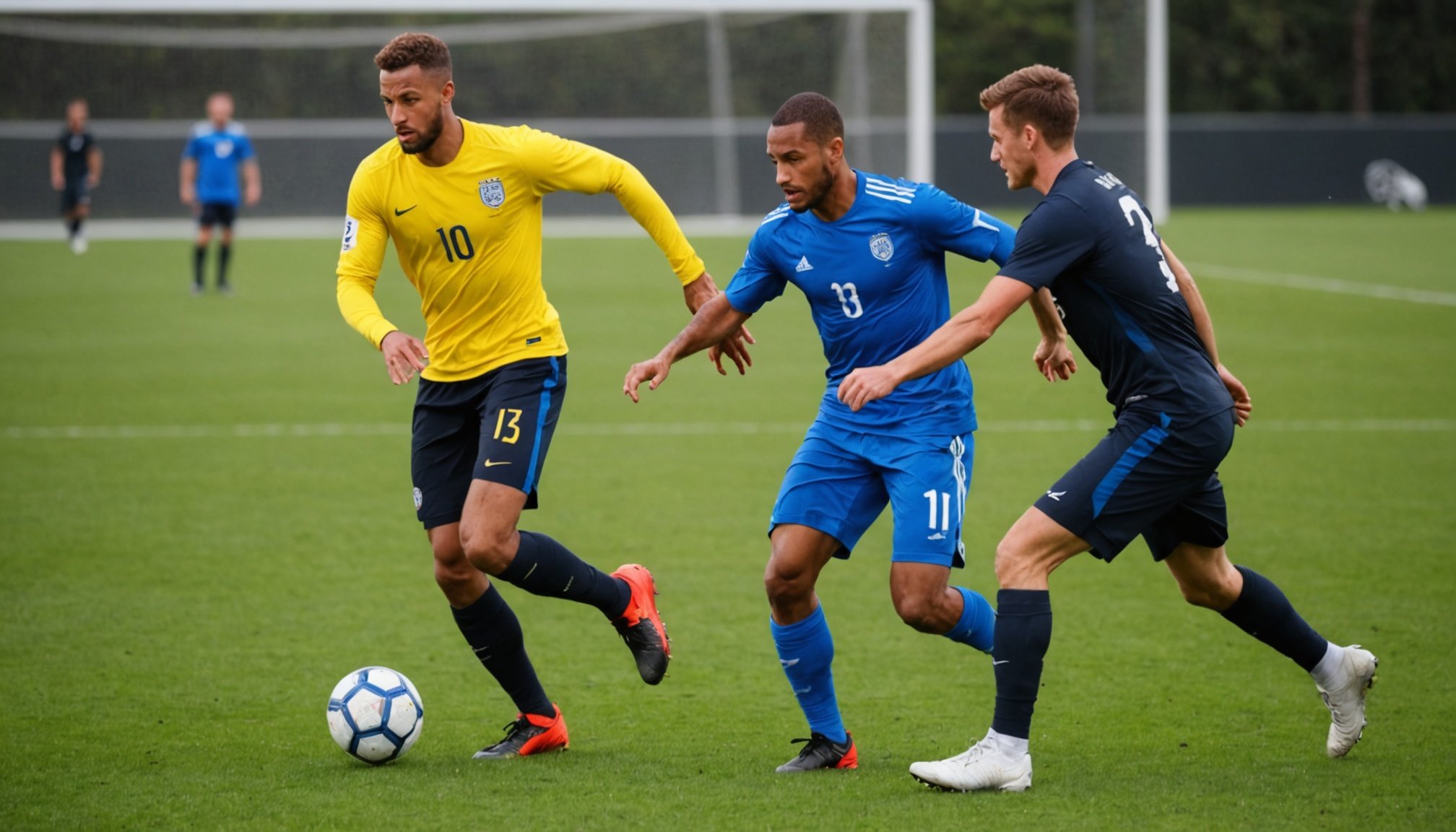Understanding One-on-One Defensive Skills
Mastering one-on-one defense is fundamental for any aspiring defender. This skill involves employing various defensive techniques to effectively thwart an opponent in a direct confrontation. The importance of excelling in one-on-one defensive skills cannot be overstated, as they are vital in preventing scoring opportunities and maintaining team stability on the field.
Key attributes of an effective defender in one-on-one scenarios revolve around player positioning and timing. A well-positioned defender maintains a stance that restricts offensive players’ movements, compelling them to reconsider their approach. By mastering body orientation and distance control, a defender can close down spaces and make it challenging for their adversary to advance or shoot.
Additional reading : Unlocking Optimal Fitness: Strategies for Football Players to Stay Fit During Injury Recovery
Beyond physical prowess, the psychological aspects of one-on-one defending are equally crucial. Defensive players must exhibit patience and composure, understanding that forcing an attacker into a mistake can be as effective as physical interventions. Building mental resilience allows defenders to maintain focus, even under pressure, turning potentially daunting situations into manageable challenges.
In conclusion, excelling in defensive techniques involves more than just physical fitness. It requires a blend of tactical acumen, psychological strength, and the ability to adeptly read and react to the opponent’s moves. By honing these skills, a defender can significantly increase their effectiveness in one-on-one duels, benefiting their team immensely.
Essential Techniques for Effective One-on-One Defense
When it comes to mastering one-on-one defense, understanding key elements such as defensive posture, tackling techniques, and body positioning is crucial.
Proper Body Mechanics
Maintaining the right defensive posture is fundamental. An effectively low stance ensures that a defender is ready to react quickly. Proper body positioning involves aligning your center of gravity to offer stability and balance. This allows defenders to stay agile, making it easier to shift directions as needed. Keeping your feet shoulder-width apart and knees slightly bent supports swift lateral movements and enhances reaction speed.
Effective Tackling Methods
Executing reliable tackling techniques requires precision. Focus on wrapping the arms solidly around the opponent while ensuring your head is up and to the side. This method reduces the risk of injury and enhances control over the opponent’s movement. Learning to tackle from various angles prepares defenders for any scenario, enhancing their versatility.
Anticipation and Reaction Skills
Reading the opponent’s movements is essential for success in defensive play. By observing body positioning and subtle shifts in weight, defenders can anticipate their opponent’s next steps. Evaluating factors such as eye direction or slight adjustments in stance can offer crucial insights. Practicing these skills during drills sharpens your ability to anticipate effectively and respond immediately.
Drills to Enhance One-on-One Defensive Skills
Mastering one-on-one defensive skills is crucial for any player committed to improving their game. When focusing on training drills specifically for defenders, consideration should be given to how various exercises can contribute to skill development. These drills aim to sharpen focus, agility, and decision-making under pressure.
A highly effective way to enhance such skills is through small-sided games. These games, often composed of fewer players, intensify the concentration on individual performance and one-on-one skill battles. For instance, a 2v2 setup augments defensive responsibilities, necessitating acute awareness and swift reactions, mirroring the fast-paced nature of an actual game.
In training sessions, incorporating game-like scenarios is fundamental. Exercises like shadow defending, mirroring the attacker’s movement without engaging in physical contact, foster anticipation and improve positioning. Similarly, reactionary drills, such as closing space quickly after an opponent receives the ball, emulate the immediacy found in competitive matches.
By embedding these practical and purposeful practice routines, defenders learn to gauge opponents accurately, gain confidence, and elevate their defensive prowess. Consistent practice of these drills ensures players are well-prepared for real-game situations, ultimately leading to refined one-on-one defensive capabilities.
Tactical Considerations in One-on-One Situations
In one-on-one scenarios, strategic decisions play a fundamental role. Mastery over tactical awareness allows players to anticipate and react swiftly to their opponent’s actions, creating a solid foundation for both offense and defense.
Understanding Opponent’s Movements
Comprehending and predicting an opponent’s next move is crucial. This involves keen observation of their body language and any preliminary signs that might hint at their intentions. Successfully reading these cues enables a player to adapt their game strategy, ensuring an optimal response to the dynamic tendencies of their adversary.
Utilizing Space and Angles
Defensive positioning greatly benefits from understanding how to exploit space and angles effectively. Positioning oneself at strategic angles creates an advantage, obstructing the opponent’s path and rendering them less effective. Consider how using sharp angles in defense can confine the opponent’s options, forcing them into less advantageous positions.
Teamwork and Communication
Communication, both verbal and non-verbal, is vital in maintaining cohesion and adjusting defensive positioning. When players synchronize their movements and relay tactical information, they form an adaptive defense capable of countering various game strategies. Recognising positions, relaying key insights, and maintaining efficient proximity on the field are crucial to improving collective performance.
Common Mistakes to Avoid During One-on-One Defending
Defensive errors are prevalent in one-on-one situations and can drastically affect the outcome of a match. One common pitfall is poor positioning, which frequently leaves defenders vulnerable to being bypassed. Proper positioning is crucial as it allows defenders to anticipate their opponent’s next move and react accordingly. To combat poor positioning, defenders should focus on maintaining an optimal distance from the attacker, balancing their weight evenly, and keeping their body oriented towards the play.
Another critical defensive error is overcommitting in tackles. When defenders overcommit, they often leave themselves out of position if the attacker skillfully evades the tackle. To avoid this, defenders should implement strategies focusing on patience and timing. By waiting until the right moment to challenge or intercept, they can increase their chances of staying with the attacker.
Skill improvement is attainable by practicing these techniques regularly. Training sessions dedicated to enhancing defensive skills, such as positioning drills and controlled tackling exercises, can help reinforce positive habits. With dedication to correcting these common pitfalls, defenders can significantly bolster their effectiveness in one-on-one scenarios, ensuring they remain a formidable barrier against their opponents.
Resources and Expert Insights for Further Improvement
To hone your skills and gain invaluable knowledge, leveraging expert opinions and educational resources is essential. These resources can bridge the gap between theory and practical application, enriching your understanding and enhancing your proficiency.
Interviews with Professional Defenders
Glean insights from interviews with seasoned defenders, providing a wealth of knowledge for anyone looking to excel. Professional insights can guide you through real-world experiences, offering advice on best practices and personal stories that reveal the nuances of effective defense strategies. Hearing firsthand how experts tackle challenges can inspire and inform your own approach.
Recommended Training Videos and Materials
Seek out training materials and compelling video tutorials tailored to fortify your skills. These resources clearly demonstrate key techniques and intricate maneuvers essential for mastery. Visual learning can be an excellent way to internalize complex concepts, with expert opinions layered throughout to ensure clarity and precision in your practice.
Downloadable Resource Guides
Access downloadable PDF guides that distill essential drills and tips into a structured format. These guides often compile the best practices shared by professionals, serving as a hands-on tool to keep you on the path to improvement. Engaging actively with these resources can facilitate significant growth and mastery.










